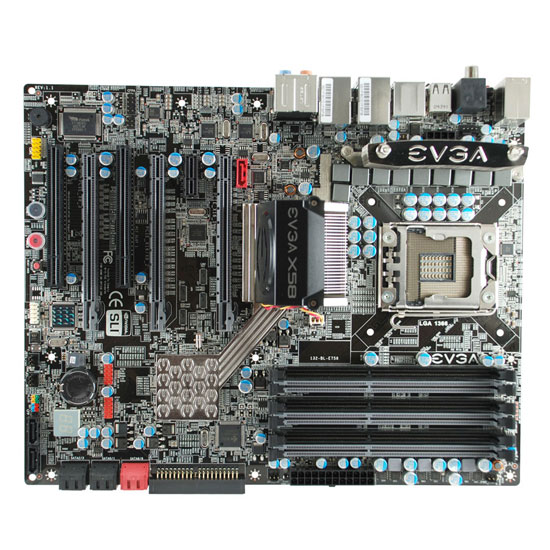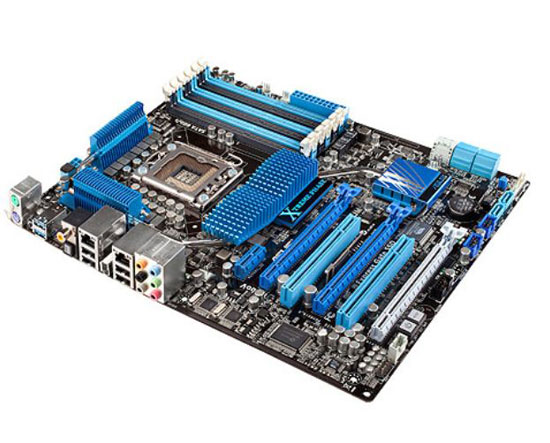Loyd's New Year - A Trio of Problem Systems
by Loyd Case on January 13, 2010 12:00 AM EST- Posted in
- Systems
The Slowly Dying Motherboard
My production system runs a Core i7 965 and 12GB of OCZ DDR3-1600 memory. The 965 clocks at 3.33GHz, and the memory runs at 1333MHz. In either case, it’s not really much of an overclock. The X58 chipset and Core i7 socket 1366 CPUs are rated at DDR3-1066 speeds officially. So technically, the memory is being overclocked.
The system was based on an eVGA X58 SLI motherboard – one of the early versions that shipped. I’d updated the BIOS as new versions came out.

Recently, I’d been having a weird series of glitches. My USB ports would stop working. Once every couple of days, I’d lose network connectivity. My audio would mysteriously stop working, even though I’d see audio activity in any media player, and the speakers seemed to be behaving correctly.
If finally occurred to me that maybe my I/O controller hub was slowly failing, or had developed an intermittent hiccup that created these seemingly unrelated issues.
So I decided to upgrade my motherboard.
My general philosophy when it comes to building the systems I actually use for productive work and personal gaming is to be somewhat conservative – if I can. Go with solutions that seem reliable and robust. I’d waited to upgrade my own system to Core i7 until I’d tested a slew of X58 boards, and the eVGA board had seemed stable. In fact, it had been running problem-free for months.
So naturally I ignored my own inclinations and bought a brand spanking new Asus P6X58D, which sported a discrete NEC USB 3.0 controller and a Marvell SATA 6gbps disc controller.

The board arrived, and seemed to install normally. Windows enumerated all the devices properly, and rebooted as expected. I installed the new drivers from the Asus DVD and rebooted.
Then a new symptom developed: after a warm boot, the fan on the Radeon HD 5870 would spin up to maximum speed and stay there. The sound was almost deafening. When this would occur, the system wouldn’t POST. Only shutting down the power supply and waiting a couple of minutes would allow for a normal boot.
Whiskey. Tango. Foxtrot.
After trying a variety of things – different CPUs, swapping in different memory, upgrading the BIOS (from 0201 to 0402) and even swapping in a different AMD graphics card, nothing changed. So I gave up. I headed out to my local friendly white box shop (Central Computer in San Jose), I picked up another Asus board: a P6TD Deluxe. The P6TD is a second (third?) generation X58 board from Asus, with more copper and 16-phase power. It’s really a souped up P6T board, but refined over the original design.

Swapped back in my original components, fired up the system and held my breath.
The system POSTed normally. Since then, I’ve run a number of applications, including some fairly system intensive games, and it’s all behaving as it should.
Lesson learned: when you need a working system for, well, work, then don’t go with the bleeding edge. I knew that already, but every now and then, I have to re-learn it. I suppose it’s my eternally optimistic nature, but I tend to believe that newer is often better. Alas, it’s not always the case.










109 Comments
View All Comments
mindless1 - Thursday, January 14, 2010 - link
... and the aforementioned "different partition than the OS partition" can conveniently be on a NAS or fileserver when dealing with several client systems, even in a cloud if you've the throughput to the *sky*.vascos - Thursday, January 14, 2010 - link
thank´s very much for this article. as a systembuilder i am used to this like every day.hardware does all test(like-prime,linx,furmark+atitool,memtest++)but we had ram(works fine on other mb) running for 2-3weeks and then instantly crashed-swapped other ram in and fine for 3month´s and hoping longer.this is with a lot of p55 mobo´s.Etern205 - Thursday, January 14, 2010 - link
While I agree the HD4870 is a old card to some extent, but I don't see it as a old card where no one wants to buy it. The card has dropped significantly in price which lets users on a budget get a card that's worth the performance within their price range.bob4432 - Wednesday, January 13, 2010 - link
this is why i always use mature to 1gen old hardware and os w/ at least a decent service pack out if i need to upgrade the os at all. w/ the exceptions of gpus, nothing else is really equal for the return on investment when you consider in the time wasted on troubleshooting bs due to "out of the gate" brand new items - let others waste their time and $$$ and when it is time for me to buy, i will build a machine using older tech that will be faster than people buying the latest because the drivers/os/support has been had a few once overs and i will save a ton of time chasing "beta" hardware output.Andreos - Wednesday, January 13, 2010 - link
I found this article very interesting, also the comments. Lets have more like this!cesthree - Wednesday, January 13, 2010 - link
I had very similar issues with my EVGA P55 FTW E657 and DRAM.My OCZ3P1600LV4GK wouldn't work at the rated 7-7-7-24-2T @ 1.65V AT ALL. Tried a slew of BIOS's and settings.
Purchased some Dominator-GT's CMG4GX3M2A2000C8, set the XMP, and was flying from the get go. 12+ hours Prime Blend AND 20+ Passes LinX stable easily.
DRAM compatibility is strange with the P55. I have seen all manufacturers forums filled with inconsistencies. Mostly there has been trouble with 1600Mhz kits.
I have also noticed where the kit would work on an AMD, and not on the i5 i7 part the kit was "designed" to work with.
Hope memory manufacturers and mobo manufacturers can get together to get this solved, or prepare for an onslaught of RMA's.
cesthree - Wednesday, January 13, 2010 - link
Looks like you were dealing with a Xenomorph.nubie - Wednesday, January 13, 2010 - link
Yep, it can sneak up on you and then bite you when you forget your own rules.Kudos on Windows 7.
Please don't say things like "not bleeding edge system. Core components include an Intel QX6850" and "older 512MB Radeon HD 4870". It makes me want to cry, I have an e5200 and 8600GTS (could be worse, the GTS is quite a bit faster than the 8600GT, it has 32.3 GB/s of RAM bandwidth for one.) I had to search and search to get this system put together, even using an OEM MSI board (missing 2nd PCI-e and parallel ports, etc) and RMA'ing it twice to get it to POST with a 45nm processor. Some people have no jobs you know.
xeopherith - Wednesday, January 13, 2010 - link
I experienced the same memory trouble you had when building a system that was for work purposes. I ended up having to trade the memory in my gaming machine with the work machine just to resolve some memory problems.Honestly it felt like a timing issue but I wouldn't get results in memtest only when running prime95 for long periods of time. After reading on OCZ's site it specifically said that the memory wouldn't work with anything but intel chipsets! I was building an AMD Phenom 940 when that was new with a Asus M4A78 Pro motherboard if memory serves. It didn't matter how much I underlocked, overvolt, undervolt, modified timings, ect.
I traded the memory for some Crucial that was specifically marked compatible on the Crucial configuration utility and holy crap it worked fine.
I have since had friends with the same problem but they certainly don't want to believe that if they pick the right frequency memory that it could be incompatible. It just goes to show you should be reading the PDFs for the motherboard and tested memory modules and or the memory manufactures tested ok modules. Both Crucial and Corsair have good documentation. I'm sure there are others but I prefer those two or OCZ.
Taft12 - Wednesday, January 13, 2010 - link
First off, good article!You are correct when you say "the state of the art in DDR3 modules seems to be evolving rapidly". I find RAM more than anything to be impossible to keep up with and fraught with incompatibilities. I now recommend only Kingston Value RAM for any system. They advertise that it is "by spec" and I see it on EVERY QVL I've ever looked at. The 1.5V is key, every vendor bumps this up. High-end RAM will gain you a couple % points in any benchmark at best, it is absolutely not worth buying anything else IMHO for anyone other than an "enthusiast" (hate that term) and even then it is money better spent on other components.
Thanks for bearing with my rant!